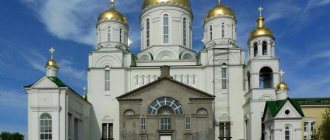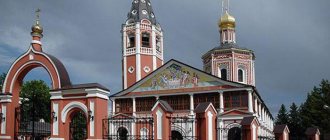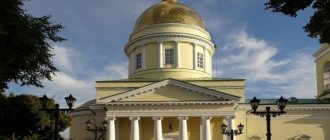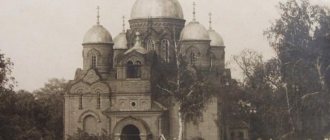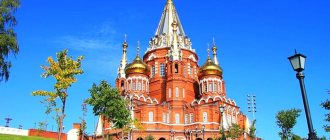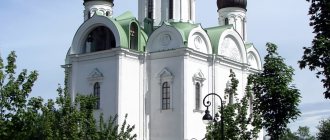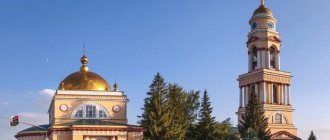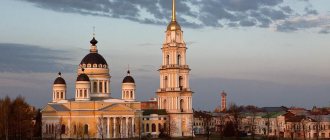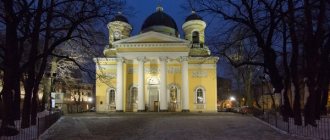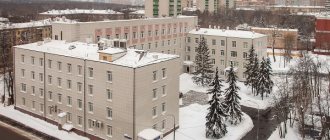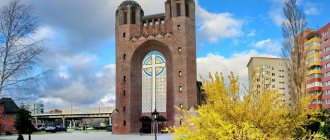It is second in size only to St. Isaac's Cathedral in the northern capital and Moscow - Christ the Savior. The most majestic building, the decoration of Voronezh, also has a very long history. The history of the city knows at least three more cathedral churches dedicated to the holiday so beloved by the people.
Annunciation Cathedral
Story
Russian church consciousness has long linked “evangelism” as the preaching of the Gospel with the Annunciation, as the beginning of our salvation. Therefore, churches dedicated to the holiday were often built on lands that were newly annexed, poorly developed, and most importantly, especially in need of the gospel and the preaching of Christ. This happened during the founding of Voronezh.
First Temple
The exact date of the founding of the city has not been established, since the royal decree about this has not been preserved. In any case, the fortress existed here at least since 1585. It was erected on a tributary of the Don, the Voronezh River, to defend the country’s borders from attacks by the Crimean and Nogai Tatars. The situation was difficult: not only military, but also spiritual. The Russian inhabitants of these places were a motley mass - from Cossacks, serving “sovereign people” to those who fled from justice, because, as they said then, “there is no extradition from the Don.” Apparently, this is why the dedication of the first city church to the Annunciation was chosen.
It is believed that a small wooden church was erected immediately after the founding of the city, but documents mention it only in 1620.
It was on the site of the current main building of Voronezh State University. It is reported in more or less detail by documents dating back to the time of the emergence of the Voronezh diocese, in the 80s of the 17th century. St. Mitrofan, the first archpastor, writes about the poor condition of the building: the rotten roof is constantly leaking, besides, near the house of God there is the so-called “circle yard”, or the location of the Voronezh drinking establishments, the region, or the location of the Voronezh drinking establishments, as well as the city prison . All this, of course, said a lot about the morals of the townspeople, who were not distinguished by either special piety or concern for church buildings.
Spiritual heart of the city
Despite the difficulties of the spiritual situation, the empty diocesan treasury of St. Mitrofan was convinced: the city needed a magnificent stone temple, which would become its spiritual center. Two years after his arrival at the department, in 1684, he received a blessing for this work from Patriarch Joachim himself, and eight years later he himself consecrated the Annunciation Cathedral. Using his own funds, Vladyka purchased church vessels and icons for the temple.
Attracted not only by the beauty of the church, but also by the holiness and virtues of the bishop, pilgrims flocked to the Annunciation. The spiritual life of the region gradually improved: under St. Mitrofan founded more than a hundred new churches and two monastic monasteries. The saint ruled Voronezh, which had already become his native city, for a little over 20 years, until his death on November 23, 1703. He was buried at the temple he founded.
New construction
The reconstruction of the temple had to be carried out under one of the successors of St. Mitrofan, Metropolitan of Pachomius (Shpakovsky). It turned out that the foundation had begun to crack, perhaps because the building was on the edge of a cliff. Therefore, the building built by St. Mitrofan, I had to disassemble it completely. By 1718, Voronezh received a new cathedral, which existed until the revolutionary events of the beginning of the 20th century.
Annunciation Mitrofanov Monastery
Since 1836, after the general church glorification of St. Mitrofan, a monastic community was formed at the cathedral - the Annunciation Mitrofan Monastery.
Destruction
The cathedral and the monastery were closed by the Soviet authorities in 1929. At the same time, its main shrine, the relics of St., was removed from here. Mitrofan of Voronezh. The fate of the building was finally decided by the Great Patriotic War: occupied by German troops, it was constantly bombarded by Soviet artillery, so that it was completely destroyed. After the war, university buildings appeared on the ruins of the former temple.
New life in a new place
The question of restoring the temple arose in the 1990s, when the Intercession Cathedral, which was a cathedral, could no longer accommodate a large number of believers. It is clear, however, that it turned out to be impossible to build the cathedral where it was previously located. The territory of the so-called Pervomaisky Square was allocated for him - a Soviet recreation park, which by that time was already very deserted.
The temple was founded by Patriarch Alexy II on November 15, 1998. Upon completion of the laying ceremony, His Holiness said:
“In the Bible there are words: “A time to destroy and a time to build... A time to throw away stones, and a time to gather up stones” (Ec. 3:3,5). I would like to believe that the time when we destroyed, when we soullessly scattered stones, has passed and will never return again. The stones of their history, the stones of their faith, the stones of their shrines..."
Eight years later, on December 6, 2009, regular services began here. The day before, a religious procession with the participation of at least 10,000 townspeople brought its main shrine, the honorable remains of St., to the temple. Mitrofan, who were in the Intercession Church.
Shrines[edit]
About three million believers from all over the country recently stood in kilometer-long queues in order to venerate, at least for a second, the great Orthodox relic from Athos - the belt of the Most Holy Theotokos, which stayed in our country for 40 days. Among those wishing to venerate the belt of the Virgin Mary were many Voronezh residents. Meanwhile, there are many significant Orthodox shrines - holy relics, revered icons, etc. - in our city. The most important of them were told in the Voronezh and Borisoglebsk diocese.
St. Mitrofan of Voronezh[edit]
The heavenly patron of the Voronezh land and one of the most revered Voronezh saints is St. Mitrofan. When the Voronezh diocese was formed in 1682, Tsar Fyodor Alekseevich proposed appointing Abbot Mitrofan as its first bishop. During his activity, many new churches were erected in the diocese. The saint supported the construction of the fleet in Voronezh, begun by Peter I, and donated funds for shipbuilding.
Saint Mitrophan died in 1703. He was buried in the Annunciation Cathedral (it was located on the site of the main building of VSU) with great honors. Tsar Peter I himself helped carry the saint’s coffin. About 100 years after the death of the saint, people began to report numerous miracles associated with his intercession. In 1832, by decision of the Synod, Mitrofan's tomb was opened, and Saint Mitrofan himself was canonized.
Soon after the revolution of 1917, the Bolsheviks burst into the Annunciation Cathedral and tried to desecrate the relics of Mitrofan. And then more than 50 thousand Voronezh residents turned to the City Council with a request to close the cathedral and remove the relics of the saint. The relics of Mitrofan were placed in the Voronezh anti-religious museum, and after the war they were transferred to the Voronezh Museum of Local Lore, located in the Intercession Church. In 1964, the then Bishop of Voronezh and Lipetsk Vladimir (Kotlyarov) was informed that good people wanted to transfer to him the relics of St. Mitrofan. At the appointed time in the evening, an unknown man appeared to him and brought a bundle of holy relics. Vladyka Vladimir placed them in his chambers. And when a year later he was sent to Syria, he asked his successor to keep the relics. In 1989, the shrine was moved to the Intercession Cathedral for public worship. Since December 2009, they have been in the Annunciation Cathedral in a malachite shrine made by Ural stone-cutters. And in the Intercession Cathedral, Metropolitan Sergius of Voronezh and Borisoglebsk ordered to leave a particle of the relics, which rests in a special reliquary.
St. Tikhon Zadonsky[edit]
Saint Tikhon of Zadonsk headed the Voronezh diocese in 1763, and four and a half years later, due to poor health, he retired to the Mother of God Monastery of Zadonsk. The saint possessed the gift of insight.
Thanks to numerous testimonies of miracles performed at his relics, he was canonized in 1861.
How did the shrine get to Voronezh? Saint Tikhon died in 1783 at the age of 59. His relics are located in the Zadonsk Nativity of the Theotokos Monastery (Lipetsk region). And in Voronezh, since 2009, a particle of the saint’s relics has rested.
Architecture Features
The project was created by V.P. Shevelev. The new temple turned out to be completely different from the old one. After all, the landmark for the architect was another cathedral lost by the city during the Soviet years, St. Vladimir. The architecture of Blagoveshchenskoye combines the traditions of Byzantine and Old Russian architecture. Some notable features of the building include:
- exceptional height: it is 84 m;
- huge crosses, the main one is 12 m high, four small ones are 6 m high;
- The largest bells in the city, the main one weighs 6 tons.
How many thrones does it have?
The upper church has a single altar dedicated to the Annunciation of the Blessed Virgin Mary (celebrated on April 7). In addition, two altars are located in the lower church:
- the All-Merciful Savior and the Life-Giving Cross of the Lord (patronal feast day August 14);
- Council of Three Russian Saints (July 19); Since the 19th century, on this day St. Dimitry of Rostov, Mitrofan of Voronezh, Tikhon of Zadonsk; two of them were Voronezh bishops.
Current activity
There are 7 priests and 4 deacons in the cathedral. There is a Sunday school at the church. Here children learn not only the basics of Orthodoxy, but also master musical notation. The academic year begins on September 10 and ends on May 27, which is marked by special prayer services.
In addition to mastering a number of disciplines, including the Church Slavonic language or church history, children take part in church services and parish life. Conversations are also held with students’ parents about proper upbringing and family structure. Parents can get advice from a priest about the peculiarities of raising a child in Orthodoxy.
Interior decoration
Iconostasis in the Annunciation Cathedral. Voronezh
It, like architecture, combines southern Russian traditions with Byzantine ones. The iconostasis has only three rows, opening the upper part of the altar space. Here you can see a mosaic altarpiece of Christ with the Blessed Virgin Mary, St. John the Baptist. This is an exact copy of a mosaic from the famous Church of Sophia of the Wisdom of God in Constantinople.
Where is it and how to get there
The unique cathedral, which adorns not only the city, but the whole country, is located in Voronezh at the address: St. Revolution, 14. The second name of its location is “Pervomaisky Garden”.
An interesting feature can be traced in the location of ancient Orthodox monasteries: after the Soviet past, many churches received a mention of the revolution or its figures in their addresses. To get to the cathedral, you can use public transport:
- by buses: No. 13n, 23k, 44n, 1nv, 9ka;
- minibuses: No. 3, 5, 50, 75, 88.
Local residents will help guests of the city find the temple, because it is one of the attractions of Voronezh. Its doors are open to Orthodox Christians every day from 7:00 to 19:00.
Having endured a series of adversities, the Annunciation Cathedral in Voronezh again shines with gilded crosses. This temple is one of the places that many pilgrims strive to visit.
If you find an error, please select a piece of text and press Ctrl+Enter.
Temple shrines
The main ones for which pilgrims come here are the honest relics of three Voronezh bishops.
Cancer with the relics of St. Mitrofan of Voronezh
St. Mitrofan Voronezhsky
He is also called the “first throne”, since the diocese itself begins with him. By the time of his appointment, Vladyka was already an experienced monk and had served as abbot of the monastery. His main task at the Voronezh department was the education of his flock, among whom there were many who had forgotten the Christian commandments. Within a few months, the Vladyka’s personal holiness won him the love of his parishioners. The saint's sermons were simple and understandable. He does not demand extraordinary feats from his flock, but wisely points out small deeds leading to the Kingdom of Heaven:
“Work hard, keep moderation, you will be rich, eat abstinently, drink little, you will be healthy, do good, avoid evil, and you will be saved.”
The saint had a special, very warm relationship with Peter I - and this despite the generally extremely ambiguous attitude of the episcopate towards the tsar. St. Mitrofan more than once donated funds from the diocese, even his own, for the construction of the Russian fleet and army, but also repeatedly instructed the sovereign, not being afraid, if necessary, to expose the autocrat. The Tsar was personally present at the funeral of the saint and carried his coffin.
Apparently, the friendship continued in the Kingdom of Heaven, where the saint now resides: at least several of his posthumous appearances are known to various people with a request to strictly pray for the soul of Emperor Peter the Great.
They pray to the saint himself for all spiritual and physical needs; many miracles happen at his tomb.
St. Tikhon Zadonsky
He headed the department for only 4 years (1763-1767), after which he retired due to illness, settling in the Mother of God monastery in Zadonsk. The Voronezh flock remembered Vladyka for his zeal for God, and also for his special grace-filled gifts. The peasants said that it was better to carry out everything said by the saint:
“You can’t disobey, he’ll complain to God!”
Since 2009, a particle of the relics of the saint of God has resided in the church.
Hieromartyr Peter (Zverev)
This archpastor had the opportunity to occupy the pulpit during times of persecution. He ruled the diocese only from 1926 to 1927, after which he was arrested and died in the Solovetsky camp. This is how one of his fellow prisoners remembers him:
“Before him, the Vokhrovites themselves, trained in rude impudence and mockery of the prisoners, hid themselves. When they met, they not only made way for him, but also did not refrain from greeting him. To which he responded as always: he raised his hand and made the barely outlined sign of the cross. If he happened to pass by the big bosses, they, seeing him from afar, turned away, as if not noticing the Orthodox bishop - an insignificant “convict”... The bosses in mirror-polished boots and deftly fitting jackets took independent poses: they yielded to the dignified calm of the archbishop. It belittled them. And she was annoyed at her own cowardice, which forced her to avert her eyes... His Eminence Peter walked slowly past, lightly leaning on his staff and without bowing his head. And against the backdrop of the ancient monastery walls it looked like a prophetic vision: the departing figure of a shepherd, as if leaving the land on which triumphant violence had established itself...”
Other shrines
Among the most revered:
- images of the Virgin Mary “Rudnenskaya”, “Hodegetria”;
- arks with particles of the relics of dozens of saints of God, icons with the relics of Spyridon of Trimifuntsky, Luke of Crimea, Joasaph of Belgorod, and other saints.
Annunciation Cathedral today
The Annunciation Cathedral today lives a full life and hosts many events and services. The cathedral currently has several departments: educational, youth, information, social, and also has a Sunday school and a library.
The educational department tries to educate parishioners on church issues, divine services and liturgies, instill a love for the temple and show the way to churching. On Fridays and Sundays, at 19:00, meetings with priests are held in. The clergy conduct discussions on the basics of Orthodox doctrine, church life, ethics and rules of conduct in church, etc.
An agreement was concluded on cooperation between the cathedral and Lyceums No. 7, 15, and the gymnasium named after. ak. N.G. Basov, secondary school No. 16, 67. Cathedral missionary Alexey Marchenko visits educational institutions, talks with students during the lessons “Fundamentals of Orthodox Culture.” The main goal of the department is to educate young parishioners in the spirit of Orthodoxy and subsequent “churching,” as well as educational work with secular youth and students.
Priest Ilya Sazonov is responsible for youth ministry in the cathedral. He attends educational institutions, incl. VSUIT, where he talks with young people, answers their questions. On Thursdays, at 19:00, meetings are held with Orthodox youth, classes are given to study the basics of Christian life and others.
The information department has existed since 2011, and an information and publishing service was created. Editorial office of the newspaper "Blagoveshcheniye"; editors of the official information website (https://sobor-vrn.ru), as well as groups on social networks.
The social department provides assistance to the elderly, disabled people, large families, the poor, people without a fixed place of residence and other people in need of help.
The department is engaged in charity work and implements social projects of the church. Provides assistance in purchasing medications, distributing things and food, provides advice on communication with relevant government agencies, and more.
The service interacts with state social and medical institutions: No. 1 and No. 2 BUZ VO “Voronezh City Clinical Hospital named after. K.V. Fedyaevsky", combined kindergarten No. 33, special correctional school No. 31 for pupils with disabilities, department of social protection of the population of the Central region.
The parish school helps families in the spiritual education of children. It provides theoretical religious and spiritual knowledge that needs to be applied in the family of Orthodox believers. The school exists without the right to form a legal entity.
The main activity of the school is to assist, first of all, children and their parents in churching, teaching them the true faith and the foundations of Christian life. During the learning process, students become acquainted with various disciplines, study the Holy Scriptures, participate in divine services and sacraments, pilgrimage trips, and religious processions.
Classes are held on Saturdays and Sundays. The spiritual care of the school's students is entrusted to Priest Oleg Shurupov. The confessor takes care of the spiritual and moral development of children, teachers, and parents.
The Orthodox library is responsible for popularizing books on spiritual topics. It opened in 2015, and today its book stock is more than 15,420 copies. It contains Orthodox encyclopedias, fiction, books by the Fathers of the Church and modern church writers, as well as various brochures and magazines.
It seems to me that in our time of information technology it is very important to remember books in general and church literature in particular. Yes, time flows, everything changes, gadgets replace paper media, but this does not mean that you can forget about the wise thoughts contained in books. The library of the Annunciation Cathedral does a great job, enlightening young people and not allowing them to deviate from the true path.
Inside
Previously, the iconostasis was huge and consisted of six tiers. Its main icons were separated from the royal doors by rich chased frames made of silver and gilded. The Holy Altar was decorated with gold and velvet; church vestments for conducting services were also made of velvet, satin and silk, and then decorated with gold and silver embroidery. The church utensils of God's house were covered with the same precious metals.
Today, the Annunciation Cathedral of Voronezh consists of two churches - upper and lower. Their total capacity is about 6,000 pilgrims.
The interior interiors of the building are made in Russian-Byzantine style. The iconostasis consists of only three rows in height, but at the same time it is huge and majestic. In its local row there are iconographic images of those saints who are most revered by pilgrims of the Voronezh diocese.
Covered with continuous carvings, skillful and delicate, the royal doors of the Annunciation Cathedral are made in the form of a deep semicircular portal. It is additionally decorated with large plates with gilded openwork overlays of floral patterns. To make these plates, the Pamir variety of lapis lazuli stone of amazing heavenly color was used.
The markings of the royal doors are not entirely traditional for Russian church architecture; they are rather close to the design traditions of ancient temples in Southern Europe. In particular, they depict a full-figure scene of the Annunciation in the upper register, and in the lower register, grouped in pairs of picturesque figures of the holy evangelists.
The low arches of the lower church made it possible to place only a two-tier iconostasis under them, however, it also looks very elegant and colorful, especially when washed by the rays of the daytime sun. The hall on the lower floor is quite spacious, the color scheme of its interiors is done in light and delicate pastel colors, wall frescoes are present only on the ceiling.
Regular services in the lower church began in April 2004, on the patronal feast of the church, after the Divine Liturgy.
And at the end of 2009, the relics of St. Mitrofan, the first bishop of Voronezh, were solemnly transferred from the Intercession Cathedral of Voronezh to the Annunciation Cathedral. For them, the Ural craftsmen made a rich reliquary from malachite, where they placed the shrines.
